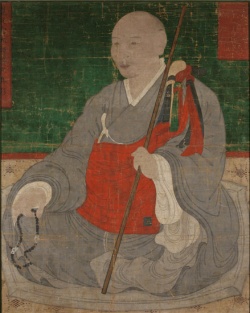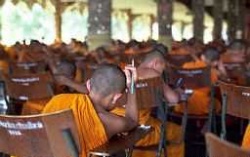Arhat
An Arhat (Sanskrit: अर्हत arhat; Pali: arahant), in Buddhism, is a spiritual practitioner (monk or layperson) who is liberated and has attained nirvana. A range of views on the attainment of arhats existed in the early Buddhist schools. The Sarvāstivāda, Kāśyapīya, Mahāsāṃghika, Ekavyāvahārika, Lokottaravāda, Bahuśrutīyas, Prajñaptivāda, and Caitika schools all regarded arhats as being imperfect in their attainments compared to buddhas. The Pali Tipitaka, the earliest of the remaining complete Buddhist canons of scripture, portrays the arhat as the final product of the Buddha's path to liberation and the goal to which all disciples aspired. The Mahayana was motivated by a more altruistic ideal in which spiritual practitioners while making efforts towards their own liberation were moved by compassion towards their fellow man and committed to helping them discover the path to liberation too. The Mahīśāsaka and the Theravāda regarded arhats and buddhas as being more similar to one another. The 5th century Theravadin commentator Buddhaghosa regarded arhats as having completed the path to enlightenment.
Etymology
The exact interpretation and etymology of words such as arahant and arhat remains disputed. In the Theravada tradition, and in early PTS publications, the word arahant or arhat is interpreted to mean the "worthy one" This has been challenged by more recent research, resulting from the etymological comparison of Pali and early Jain Prakrit forms (arihanta and arahanta). The alternative etymology is "foe-destroyer" or "vanquisher of enemies," which corresponds to the Jain definition. The latter challenges the assumption that the root of the word is Pali araha (cf. Sk. arha); Richard Gombrich has proposed an etymology of ari + hanta, bringing the root meaning closer to Jina (an epithet commonly used of both the leaders of the Jain religion and Buddha).
The term arhat was translated into East Asian languages phonetically as a transliterated term, exemplified in the Chinese āluóhàn (Ch. 阿羅漢), often shortened to simply luóhàn (Ch. 羅漢). However, the Tibetan term for arhat was translated by meaning from Sanskrit. This translation, dgra bcom pa, means "one who has destroyed the foes of afflictions." This Tibetan translation of the meaning conforms with the Jain definition as well.
Arhat occurs as arhattā in the Rigveda and as the first offer of salutation in the main Jain prayer, the Namokar Mantra. Based on a possible Sanskrit etymology, Arhant can be translated as deathless since "hant" in Sanskrit means death or killing and "ar" is often used for negation, implying "cannot be killed" or "beyond death" or "deathless". This fits well with the central philosophical thought in buddhism, namely, "by realizing the true nature of phenomenological existence we transcend the cycle of life and death and become deathless in spiritual sense." A similar transcendental spiritual state of being is referred to in the highly regarded Mahamrityunjaya Mantra, which also occurs in Rigveda and often called by sages as the heart of the Vedas. The latter word occurs mostly in Buddhist and Jain texts, but also in some Vaishnava works such as the Bhagavata Purana. Arhattā also occurs in the Vaishnava Srī Narada Pañcaratnam.
In the early Buddhist schools
According to tradition, many disciples of the Buddha became arhats in his lifetime. These included Sariputta, Upali, Maudgalyayana, Mahakasyapa, Katyayana, Khema and Uppalavanna.
In pre-Buddhist India the term arhat, denoting a saintly person in general, was closely associated with these two qualities, miraculous power and asceticism. The Buddhist drew a sharp distinction between their Arhat and Indian holy men in general, in Buddhism these miraculous powers were no longer central to arhat identity or to his mission.
A range of views on the relative perfection of arhats existed amongst the early Buddhist schools. In general, the Mahāsāṃghika branch, such as the Ekavyāvahārikas, Lokottaravādins, Bahuśrutīyas, Prajñaptivādins, and Caitika schools, advocated the transcendental and supermundane nature of the buddhas and bodhisattvas, and the fallibility of arhats. The Caitikas, for example, advocated the ideal of the bodhisattva (bodhisattvayāna) over that of the arhat (śrāvakayāna), and they viewed arhats as being fallible and still subject to ignorance.
According to A.K. Warder, the Sarvāstivādins held the same position as the Mahāsāṃghika branch regarding arhats, considering them to be imperfect and fallible. The Kāśyapīya school also held the doctrine that arhats were fallible and imperfect, similar to the view of the Sarvāstivādins and the various Mahāsāṃghika sects. The Kāśyapīyas believed that arhats have not fully eliminated desires, that their "perfection" is incomplete, and that it is possible for them to relapse.
In Theravāda Buddhism
In Theravada Buddhism, it means anyone who has attained Nirvana, including the Buddha himself. In the liturgy of Theravada Buddhism used in monasteries throughout the world the following words are recited daily:
- Namo tassa bhagavato, arahato, samma-sambuddhassa
- (Homage to him, the Blessed One, the liberated, the fully enlightened).
The arahant is a person who has eliminated all the unwholesome roots which underlie the fetters – who upon decease will not be reborn in any world, since the bonds (fetters) that bind a person to the samsara have been finally disolved. In the Pali Canon, the word is sometimes used as a synonym for tathagata.
After attainment of Nibbana, the five aggregates (physical forms, feelings/sensations, perception, mental formations and consciousness) will continue to function, sustained by physical bodily vitality. This attainment is termed the nibbana element with a residue remaining. But once the Arahant pass-away and with the disintegration of the physical body, the five aggregates will cease to function, hence ending all traces of existence in the phenomenal world and thus total release from the misery of samsara. It would then be termed the nibbana element without residue remaining. Parinibbana occurs at the death of an Arahant.
In Theravada Buddhism the Buddha himself is first identified as an arahant, as are his enlightened followers, because they are free from all defilements, without greed, hatred, delusion, ignorance and craving, lacking "assets" which will lead to future birth, the arahant knows and sees the real here and now. This virtue shows stainless purity, true worth, and the accomplishment of the end, nibbana.
In the Pali canon, Ānanda states that he knows monastics to achieve nibbana in one of four ways:
- one develops insight preceded by serenity (Pali: samatha-pubbaṇgamaṃ vipassanaṃ),
- one develops serenity preceded by insight (vipassanā-pubbaṇgamaṃ samathaṃ),
- one develops serenity and insight in a stepwise fashion (samatha-vipassanaṃ yuganaddhaṃ),
- one's mind becomes seized by excitation about the dhamma and, as a consequence, develops serenity and abandons the fetters (dhamma-uddhacca-viggahitaṃ mānasaṃ hoti).
In Theravada, although the Arahants have achieved the same goals as the Buddha, there are some differences among Arahants due to the way of their practice.
In the Pali Canon, the word "tathagata" is sometimes used as a synonym for arahant, though the former usually refers to the Buddha alone.
These three awakened beings are classified as Arahant:
- Sammasambuddha, usually just called Buddha, who discovers the truth by himself and teaches the path to awakening to others.
- Paccekabuddha, who discovers the truth by himself but lacks the skill to teach others.
- Savakabuddha, who receive the truth directly or indirectly from a Sammasambuddha.
For those that have destroyed greed and hatred (in the sensory context) with some residue of delusion, are called anagami (non-returner). Anagamis will not be reborn into the human world after death, but into the heaven of the Pure Abodes, where only anagamis live. There, they will attain full enlightenment.
Buddhaghosa regarded the arhat as the final product of the path to liberation and the goal to which the disciple aspired.
In Mahāyāna Buddhism
Mahāyāna Buddhists see the Buddha himself as the ideal towards which one should aim in one's spiritual aspirations. In Mahāyāna Buddhism, a hierarchy of general attainments is envisioned, with the attainments of arhats and pratyekabuddha being clearly separate, and below that of fully enlightened buddhas (Skt. samyaksaṃbuddha), or tathāgatas, such as Gautama Buddha.
In contrast to the goal of becoming a fully enlightened buddha, the path of a śrāvaka in being motivated by seeking personal liberation from saṃsāra, is often portrayed as selfish and undesirable. There are even some Mahāyāna texts that regard the aspiration to arhatship and personal liberation as an outside path. Instead of aspiring for arhatship, Mahāyāna Buddhists are urged to instead take up the path of a bodhisattva, and to not fall back to the level of arhats and śrāvakas. Therefore, it is taught that an arhat must go on to become a bodhisattva eventually. If they fail to do so in the lifetime in which they reach the attainment, they will fall into a deep samādhi of emptiness, thence to be roused and taught the bodhisattva path, presumably when ready. According to the Lotus Sūtra (Skt. Saddharmapuṇḍarīka Sūtra), any true arhat will eventually accept the Mahāyāna path.
The Mahāyāna teachings often consider the śrāvaka path to be motivated by fear of saṃsāra, which renders them incapable of aspiring to buddhahood, and that they therefore lack the courage and wisdom of a bodhisattva. Novice bodhisattvas are compared to śrāvakas and arhats at times. In the Aṣṭasāhasrikā Prajñāpāramitā Sūtra, there is an account of 60 novice bodhisattvas who attain arhatship despite themselves and their efforts at the bodhisattva path, because they lacked ability in prajñā-pāramitā and skillful means to progress as bodhisattvas toward complete enlightenment (Skt. Anuttarā Samyaksaṃbodhi). This is because they are still viewed as having innate attachment and fear of saṃsāra. The Aṣṭasāhasrikā Prajñāpāramitā Sūtra compares these people to a giant bird without wings that cannot help but plummet to the earth from the top of Mount Sumeru.
Mahāyāna Buddhism has viewed the śrāvaka path culminating in arhatship as a lesser accomplishment than complete enlightenment, but still accords due respect to arhats for their respective achievements. Therefore, buddha-realms are depicted as populated by both śrāvakas and bodhisattvas. Far from being completely disregarded, the accomplishments of arhats are viewed as impressive, essentially because they have transcended the mundane world. Chinese Buddhism and other East Asian traditions have historically accepted this perspective, and specific groups of arhats are venerated as well, such as the Sixteen Arhats, the Eighteen Arhats, and the Five Hundred Arhats. The first famous portraits of these arhats were painted by the Chinese monk Guan Xiu (Chinese: 貫休; pinyin: Guànxiū) in 891 CE. He donated these portraits to Shengyin Temple in Qiantang (present day Hangzhou) where they are preserved with great care and ceremonious respect.
In some respects, the path to arhatship and the path to complete enlightenment are seen as having common grounds. However, a distinctive difference is seen in the Mahāyāna doctrine pushing emotional and cognitive non-attachment to their logical consequences. Of this, Paul Williams writes that in Mahāyāna Buddhism, "Nirvāṇa must be sought without being sought (for oneself), and practice must be done without being practiced. The discursive mode of thinking cannot serve the basic purpose of attainment without attainment."


